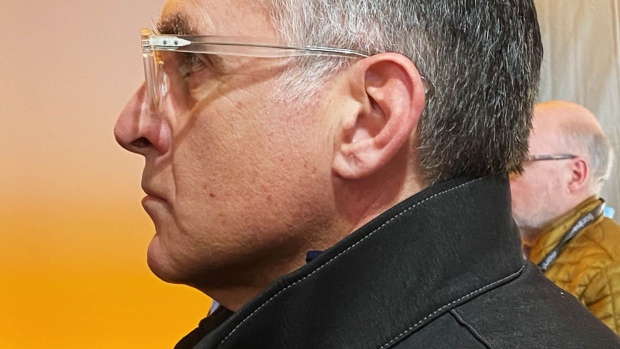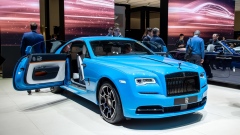Jan 23, 2020
Looking for a Rare Classic Car? Meet the Man Billionaires Trust
, Bloomberg News

(Bloomberg) -- “Looks like I’m buying dinner tonight!” Steve Serio grins broadly as his friends slap his back and give him fist bumps.
Across a wide, white tent in dusty Scottsdale, Ariz., a round of applause breaks out in approval. The Boston-based car dealer has just sold his 1958 Mercedes-Benz 220 S Cabriolet for $140,000, beating the estimate that auction house Gooding & Co. had set for the silver droptop to fetch that day.
“It was touch-and-go for a minute there,” Serio says, nodding to a thumbs-up proffered from a buddy across the room. Bidding had stalled momentarily at $100,000, but the irascible British auctioneer up front, Charlie Ross, wouldn’t stand for it. Ross prodded, teased, scolded, and charmed the crowd until bidding regained momentum and sent the price on the screen to $115,000 and then on higher. At that point, Serio knew he had at least broken even. Anything more would be cake.
Behind the Curtain
Welcome to Day Three of the Scottsdale Auctions, an annual event held for the past three decades. It’s the unofficial first stop on the premier car-collecting circuit, a route that runs through the Retromobile show in Paris, the Amelia Island Concours d’Elegance, Monterey Car Week, and the Villa d’Este Concours d’Elegance on Lake Como, just outside Milan.
And Steve Serio, with an entry-level Jeep rented for the occasion, an understated wristwatch, and a genial but reserved manner, is there to work.
Serio is among the top tier of an elite underground network of consultants and experts who operate behind the scenes to buy and sell most of the world’s blue-chip vehicles. Their black books contain the contact details of African billionaires and Swiss banking scions looking to build entire car collections. Lunchtime table banter with this group can turn surreal: “He wanted to give me $300 million for a five-year play, but I told him that’s crazy—let’s start with $30 million for now. That will build a great collection.”
Their phones buzz morning, noon, and night with calls from real estate barons searching for a fifth ultra-rare racing Ferrari to buy or media-shy entertainers looking to sell their seven-figure “plastic” Porsches, a nickname for the very lightweight, very low and slim Porsche race cars from the late 1960s. Pop stars tap them to dispense of Alfa Romeos once they have lost the blush of novelty. Collectors too famous to attend public auctions without causing a scene use them as hired guns to secure the sale of a coveted machine. Pharmaceutical industry titans with neither the time nor the patience—nor, says Serio, the self-control—to bid on classics themselves call on them to do it instead.
For the inside hook on prewar American cars, try Mark Hyman in St. Louis. If you prefer coach-built prewar and touring cars—Alfa Romeos from the 1950s to the ‘70s, or, say, unusual Italian cars currently being stored in Japan—ask Serio’s colleague, Peter Brotman.
But if rare European exotics are your thing, the 60-year-old Serio leads the ranks. He’s gone from an automotive dealership owner (Bugatti, Saleen, Lotus, Aston Martin, among others) to independent consultant. Outside Scottsdale, he is most likely found on his back in a dusty barn in Germany inspecting rust on the chassis of an old Porsche or kicking Bizzarrini tires in a climate-controlled collection in Italy on behalf of his exceedingly discrete, even secretive, clients.
“I’m a chameleon,” says Serio, who at one point or another seems to have worked deeply in even the most obscure makes and marques. “I’ll move as fast as I can into [a potential] market, if I can identify it.”
That afternoon at the Gooding auction, Serio quickly notes the difference between a $2 million Mercedes-Benz 300 SL and one worth far less. As a 1958 SL painted the color of a fire engine rolled across the auction block, he notes, “1958 doesn’t qualify for any of the major rallies, and red on an SL is the kiss of death.” Two minutes later, it sells for $850,000—a paltry sum in the 300 SL world.
Later, in the viewing area, he wiggles underneath a black car, iPhone flashlight in hand, to inspect how the fenders have been welded on. He might also find signs of repairs that have not been disclosed. The difference between him or another guy doing such minute surveillance is that Serio knows at a glance whether the etching on the headlight is wrong—a clue that it is not period-correct—or if the metal holder encircling the headlight should not have been polished so brightly. “Over-restored” is a thing, too.
He will also know and call the guy who, he’ll remember, owned the car last year, in order to get the real story as to why it’s being offered for sale now. You’d be surprised at how many expensive, important cars are offered momentarily on Bring a Trailer and then, as if by magic, are offered later at a prestigious auction. Or vice-versa. It’s rarely a good sign—and always a bad look—when a car has been offered for sale on several different platforms or venues. Serio will remember which is which.
The Power of the Game
Along with Brotman, who keeps his own roster of well-heeled clients, Serio spent four days lodged in the Arizona Biltmore Hotel designed by Frank Lloyd Wright a century ago. They were laying the groundwork for deals that would play out over the rest of the year.
They discussed whether to hold a 911R for Amelia or to sell it before the event; compared notes on a black 1958 Porsche 356 speedster with a dark green interior; and for another client placed a bid on a purple metallic 1991 Vector that looks like it came straight from ‘90s-era MTV. Tag-teaming, they’re even more effective: When they heard from a client who was recently looking for a missing Ferrari 365GTS California Spyder—one of 14 existing today—they located two. It took them fewer than 48 hours.
Serio speaks on several expert panels during auction week as well, including one at the members-only Otto Car Club hosted by Road Scholars, a Pebble Beach award-winning restoration company. It was a meeting exclusive to owners and aspirants of the ultra-rare Abarth Porsches, cars that routinely fetch millions of dollars and are so beloved they’re passed quietly from one owner to another, never to be seen at auction. Brotman, who has 30 years of contacts built up in his head, expects to come out of the weekend with two or three big deals gleaned from networking alone: “It could be a $5 to $7 million weekend,” he says, nonchalantly.
Strategic Diversification
Extracurriculars aside, the main goal this week for Serio is to sell three classic cars, a task he has plotted for the better part of a year. In addition to the silver Mercedes cabriolet, there’s a 1956 Jaguar D Type Tempero replica that he acquired by trade from a fellow dealer on the West Coast. (He’d owned a similar model 20 years ago and missed driving it.) There’s also a white 1938 BMW 328 Roadster he bought last year on a tip. “We knew it was a great car and thought, ‘Let’s just take a shot,’” Serio says.
He matches each car to the auction house he determines best-suited to sell it—Gooding for the Mercedes, because he knows the charismatic Brit Ross will eke out every last dime he can get on something he’s listing with no reserve. He sends the Jaguar to RM Sothebys because the auction house has historically done well selling that particular continuation model. The placement of the BMW, too, works out fortuitously: A similar 328, in an aged minty green color and owned by one family for 75 years, grabs headlines when it appears in the catalogue for the Gooding auction. Serio doesn’t want his white BMW to be overshadowed by the green one with its slightly superior pedigree, so he is happy to go with Bonhams on that one.
“I don’t negotiate against myself,” he puts it.
A Critical Eye
Typically, auction houses collect 12% of the hammer price from the buyer, up to $250,000; anything above that is on a sliding scale. Sellers typically pay 10% as private individuals. But longtime dealers such as Serio can negotiate smaller fees—or even have them waived entirely—for themselves and their clients. The savviest negotiate different terms with each auction house to their own advantage. Serio typically earns a double-digit percentage from his clients for his troubles, which he splits with such associates as Brotman, if the deal requires.
That ability to garner favorable terms isn’t the primary reason Serio and co. have full date books for sales months in the future and for multiyear long-term plays. It’s about their encyclopedic knowledge of obscure makes and models; a network of collectors, brokers, mechanics, and restorers, mostly gained by word-of-mouth; and old-fashioned common sense.
“I’m used to being disappointed,” Serio says. “And then, one time, I’ll find that 550 A Porsche that had been missing for 50 years in a garage in Dusseldorf. These things still exist, they’re still out there. You just need to know where to look.”
More subtly, the job is also about navigating the ethical cesspool of used-car sales, which, after all, is ultimately what auctions are—even if they do serve Champagne swirled with the glitz of red carpet and chandeliers. Car auctions are a largely unregulated business that exist, let’s not forget, to enrich the auction houses, not consumers. Sorting through VIN numbers, international registrations, back-end buyback guarantees, and the level of restoration or lack thereof—notoriously difficult to verify—on a million-dollar piece of rolling art is a full-time job. “I deal with liars, cheats, and thieves on a daily basis,” Serio says with a wry grin.
Those who are not so lucky to have Serio or one of his brethren by their sides might resort to carrying magnets in their pocket for an easy test to see if Bondo has been applied. (If the magnet doesn’t stick to the side of the car, it’s a sign that a repair or previous collision has occurred.) I saw one man in Scottsdale use a handheld device to detect the thickness of the paint on a red Ferrari Testarossa—which helped him determine how original the paint job was.
On to the Next One
The sale of Serio’s vintage Mercedes with the whitewall tires and patina-ed leather seats is especially sweet, considering its timing: It’s the only one of his million-dollar bunch to sell this week. Neither the Jaguar D Type nor the BMW 328 Roadster meet their reserve price, for reasons that vary, depending on whom you ask.
“Every year, it’s something: devaluing of the euro, Brexit, Harry and Meghan, the election, you name it,” Serio says. “You can’t get emotional about these things. This is just another day in the office—this just happens to be the office.”
The morning after the last auction, we meet for coffee to debrief the sales. Serio is crowing about the veal last night at his favorite Italian spot, where he hosted a dinner for a dozen major collectors. Brotman, saying a quick goodbye, will drive to Los Angeles to visit a valued client.
Later, Serio texts an update: The Jaguar will find its way to Bring a Trailer, and the BMW is being shopped to a buyer of means in the U.K. He has hitched a ride back to Boston in a friend’s private jet—another day at the office, this time sky-high. “Sometimes you throw more than one dart to find the board,” he says.
To contact the author of this story: Hannah Elliott in New York at helliott8@bloomberg.net
To contact the editor responsible for this story: James Gaddy at jgaddy@bloomberg.net
©2020 Bloomberg L.P.


